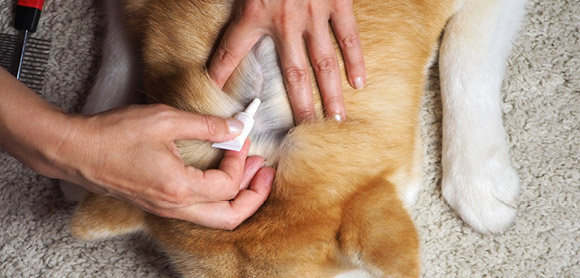Fleas are a common problem, but how do dogs get fleas in the first place? And what treatments are available to get rid of them? Find answers below.
Scratch, scratch, scratch – the noise dog owners associate with the potential presence of fleas. Adult dog fleas (Ctenocephalides canis) survive by sucking the blood of their host, but in addition to dogs, they can also bite other species including cats and humans.
Because they’re such a common external parasite, it’s important to know where your dog might catch fleas – and what to do if you spot signs of an infestation.
How do dogs get fleas?
Dogs can catch fleas in all kinds of ways, including:
- From wildlife
- From other pets with fleas
- From people bringing fleas, eggs, pupae or larvae into the house on their shoes or clothes
- From flea eggs or larvae left on carpets, bedding, and other soft furnishings
If your dog’s flea prevention treatments are up to date, then any adult fleas that do come into contact with your dog won’t be able to survive. Some treatments also contain active ingredients that target flea eggs and larvae.
If your dog’s flea treatments aren’t up to date, you might notice signs that your dog is getting bitten.

Flea bites in dogs
From minor irritation to allergic reactions and internal parasites, dog fleas can create a range of health issues, including:
- Irritation: When fleas bite your dog, the saliva acts as an irritant, causing temporary itching.
- Allergic reaction: Some dogs are allergic to flea saliva and can develop Flea Allergy Dermatitis (FAD) with severe irritation, inflammation, and potential infections.
- Blood loss: A heavy flea infestation can lead to blood loss from so many bites. This can cause serious issues, especially in puppies and senior dogs.
- Internal parasites: Fleas can sometimes carry tapeworm eggs, which may infect your dog if they ingest fleas while grooming themselves.
Fleas are more common in spring and summer as temperatures start to rise, but they can cause problems all year round, especially if your house is centrally-heated.

Signs and symptoms of fleas in dogs
If you’re concerned your dog might have fleas, look out for these signs:
- Scratching
- Nibbling at skin
- Areas of hair loss
- Thick skin, particularly on ears
- Small red spots or patches of skin

What do fleas look like on dogs?
Fleas are tiny, so you might not initially spot them on your dog. Sometimes they’re easier to spot, especially in breeds with thinner coats like Boxers and Greyhounds. On dogs with thicker, double coats like German Shepherds and Border Collies, they’re often harder to see.
As fleas multiply, you might start to see signs including:
- Black specks of ‘flea dirt’ in your dog’s coat
- Fleas on your dog’s skin (these are easier to spot on your dog’s belly)

How to check for fleas
If you can’t see any fleas but suspect your dog has them, here’s how to check:
- Dampen a piece of kitchen towel and place it on a flat surface
- Groom your dog with a fine-tooth comb
- Tap any dirt from the brush onto the damp kitchen towel
- Look out for any small black specks of dirt
- If, after a few minutes, the black specks create small, red-brown patches on the kitchen towel, your dog has fleas
These tiny black specks are known as flea dirt but are actually flea droppings. If you do see signs of fleas, it’s important to treat your dog as soon as possible.

How to treat fleas on dogs
There are a range of flea treatments available for dogs, including:
- Spot-on liquids
- Tablets
- Collars
- Shampoo
If your dog does get fleas, it’s also important to treat them for internal parasites like tapeworms.

How often should you flea your dog?
It’s much easier to prevent your dog from getting fleas in the first place than to deal with an infestation in your home. Flea treatments need to be re-applied regularly, but the frequency will depend on the type and brand of product you’re using. Your vet can help you find the best option for your dog.
The flea life cycle includes four stages: egg, larva, pupa and adult. An adult female flea can lay up to 50 eggs per day and flea pupae can lie dormant for up to a year. If your dog does have fleas, you’ll also need to treat your house as well, by:
- Vacuuming carpets and soft furnishings
- Using an insecticide spray designed to kill adult fleas, larvae and eggs
- Washing your dog’s bed once a week on a high-temperature setting, especially during warmer months
Have you got any tips for avoiding fleas on dogs? Share your suggestions on our Facebook page.